Reviews
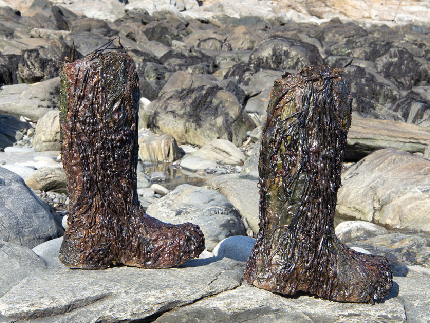
Feature Article “Rising Seas: The Visions of Celeste Roberge”
A 10 page photo/essay published in Senior Hiker Magazine in March 2020. View the PDF of the photo/essay.
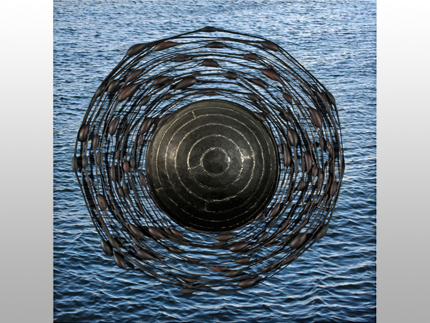
Feature article “Seaweed Dreams” by Bob Keyes in the Portland Press Herald, Maine
View article: “http://mainetoday.com/maine_art/celeste-roberge-art-seaweed/

Feature Article on the Seaweed Boats
Feature Article in Maine Boats, Harbors and Homes by Carl Little “Art Flotilla: Celeste Roberge’s Seaweed Boats Float the Imagination”.
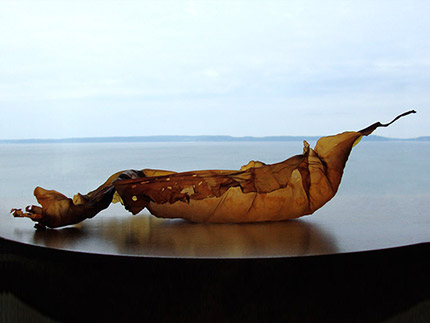
Ocean Floors Exhibition Brochure
Ocean Floors exhibition at the Crisp-Ellert Art Museum, Flagler College, St. Augustine, Florida. View brochure PDF: Ocean Floors.

Catalogue of Maine Women Art Pioneers III
Maine Women Art Pioneers III at the University of New England Art Gallery, Portland, Maine.
Celeste Roberge explores impermanence and futility with her fragile seaweed boats, so delicate as to be transparent, and surely incapable of entering the water without returning immediately to their amorphous, osmotic state. Particularly for an artist like Roberge, who has created permanent, commissioned sculptures for collections from Maine to California, there is an irony in creating art that can so readily un-create itself. The irony is extended in the more solid bronze versions of these seaweed boats which Roberge has pierced with holes so that they, too, can neither hold anything nor float. Roberge’s oarless boats, with their pronounced bow-sprits, are timeless and iconic in appearance.—Jessica Skwire Routhier, an excerpt from the catalogue essay

Celeste Roberge: Cyanotypes Exhibition Pamphlet
Celeste Roberge: Cyanotypes. University of South Florida, Undergraduate Research Initiative in Printmaking, St.Petersburg, Florida with Bleu Acier, Inc, Tampa, Florida.
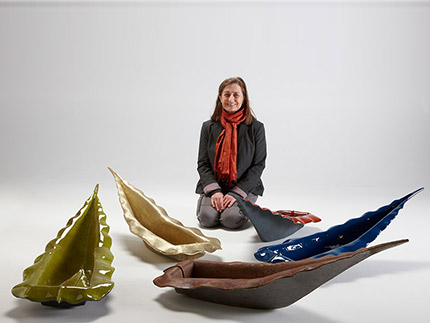
Maine Home and Design
Feature article in Maine Home + Design Magazine. A sculptor at Large. Working with the “STUFF OF THE EARTH,” This artist-teacher creates objects that amaze and provoke.
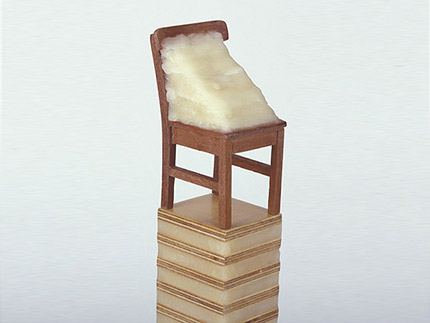
On the exhibition Mountains and Miniatures, Aucocisco Contemporary, Portland
In Copper and Slate Stack, neat squares of copper, slate and plywood are arranged in repeated order, rising 17 inches from the ground. The layers of material suggest geologic strata. Perched precariously on the top like an eccentric throne is a miniature armchair in a 1950s ‘modern’ style, its seat filled with a ball of copper wire. Eight of the stacks pay tribute to modern masters: Meret Oppenheim, Alberto Giacometti, Yayoi Kusama, Donald Judd, Eva Hesse and Joseph Beuys. Fur Covered Chair (for Meret Oppenheim) is a 19-by-2-by-2 inch construction of plywood and mahogany obscured by fur. In Piano Stack (for Beuys), a miniature baby grand covered with felt is set on a handsome 47-inch-tall pedestal of wood and copper. These appropriations elicit a knowing smile, while the meticulous craft of the miniature constructions conveys something of Roberge’s own sensibility. The sculptural inventions contrast with three ‘mountains,’ craglike forms of a more home-made appearance that have miniature chairs atop their peaks. Inspired by the distinctive shape of Mont St.-Michel on France’s Normandy coast, these plaster and Hydrocal objects rise a bit over a foot in height and are accented with basalt, slate, textiles, and metal. The show also featured a dozen gouache, watercolor and ink drawings, with gold and copper leaf, graphite and collage elements. Related to the sculptures, they add another dimension to the work: the plotting of enticing ideas.—Carl Little, Art in America, June/July 2007
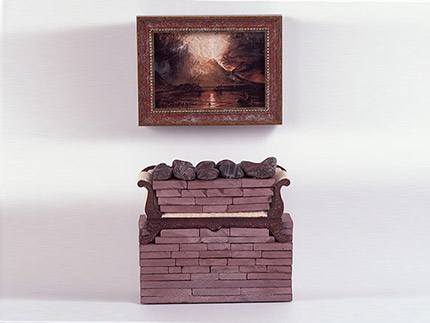
On the Miniatures:
Some are positioned below tiny reproductions of paintings, creating miniature tableaux that drop with little warning into an abyss below. Others are left standing stark and alone atop columns built in sedimentary layers from the same materials used to fashion the chairs themselves, the chair itself appearing as the last material moment in a vertical blur of repeating intervals—as though its own ascent toward the heavens were recorded not by film but by wood, plaster, or stone—its stuttering past fused with its frozen present. While diminutive in actual size, the form and proportions of her sculptures somehow conspire to permit us to experience them as colossal.—Chris Thompson, The Portland Phoenix, July 18, 2003
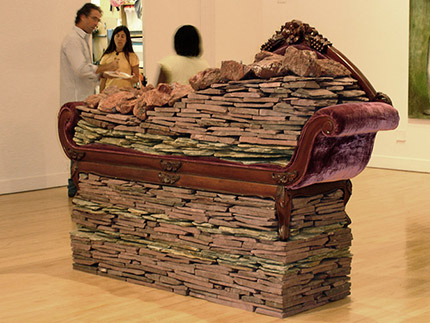
On the Stacks:
The leitmotif of her sculptures is, unexpedtedly, the Victorian-era chaise lounge. To find these undulating forms embedded in the heavy layers of rock is alarmingly surreal, the sharpness of the rocks uncomfortably juxtaposed against the physically-inviting furnishings. Tufted upholstsery and gracefully curved and carved wood suggest time long past, reclining female figures, and drowsy, sensual languor. Roberge’s sculptures are nearly a modern deconstruction of Antonio Canova’s 19th century marble sculpture Pauline Borghese as Venus Victorious.—Debora Rindge, Art Papers Magazine, March/April 1999
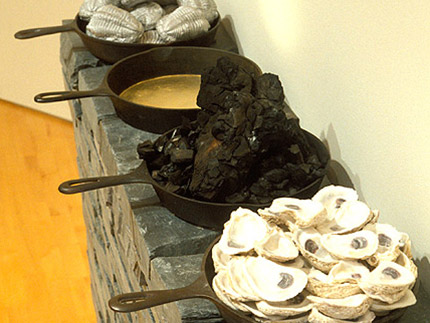
On Stacks for Home and Office:
Celeste Roberge’s latest series offers a paean to cataclysmic activity. Her assemblages of river rocks, fabricated steel, and other materials constitute miniature foundries that symbolize creation dynamics on a global scale. Several sculptures include cast-iron skillets, a clever reference to the notion of Earth as a huge cooking furnace. The sculptures can also be read as powerful metaphors for the tumultuous processes of artistic creation itself.—The Week, NYC, June 20, 2003